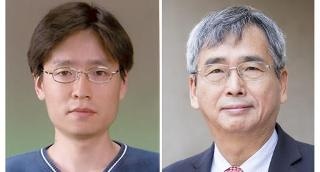Jun 11 2018
Magnetic islands, or structures resembling bubble that are formed in fusion plasmas, can proliferate and disturb the plasmas and prove detrimental to the doughnut-shaped tokamak facilities in which fusion reactions are carried out. In a recent study performed at the U.S. Department of Energy’s (DOE) Princeton Plasma Physics Laboratory (PPPL), extensive computer simulations were used to develop a new model that could provide important insights into the way these islands interact with the surrounding plasma when they proliferate and cause disruptions.
 KSTAR physicist Jae-Min Kwon, left, and PPPL physicist C.S. Chang. (Image credit: National Fusion Research Institute, left, and Elle Starkman)
KSTAR physicist Jae-Min Kwon, left, and PPPL physicist C.S. Chang. (Image credit: National Fusion Research Institute, left, and Elle Starkman)
The outcomes of the study, which have the potential to revoke long-held presumptions of the structure and effect of magnetic islands, have been obtained from simulations headed by visiting physicist Jae-Min Kwon. Kwon, who was on a year-long sabbatical from the Korean Superconducting Tokamak Advanced Research (KSTAR) facility, collaborated with physicists from PPPL to model the elaborate and astonishing experimental observations recently made on KSTAR.
Researchers Intrigued
The experiments intrigued many KSTAR researchers including me. I wanted to understand the physics behind the sustained plasma confinement that we observed,” he stated. “Previous theoretical models assumed that the magnetic islands simply degraded the confinement instead of sustaining it. However, at KSTAR, we didn’t have the proper numerical codes needed to perform such studies, or enough computer resources to run them.
Jae-Min Kwon, First Author
The circumstances led to Kwon turning his focus to PPPL, where he has had interactions for many years with physicists who work on the robust XGC numerical code developed at the Laboratory. “Since I knew that the code had the capabilities that I needed to study the problem, I decided to spend my sabbatical at PPPL,” he stated.
From 2017, Kwon has been working closely with C.S. Chang, a principal research physicist at PPPL and leader of the XGC team, as well as PPPL physicists Seung-Ho Ku and Robert Hager. The scientists used plasma conditions from the KSTAR experiments to model the magnetic islands. The structure of the islands was evidently distinctive from standard assumptions, as was their effect on plasma confinement, turbulence, and plasma flow at the time of fusion experiments.
In fusion, the power driving the sun and stars, light atomic elements in the form of plasma - the hot, charged state of matter formed of atomic nuclei and free electrons - are fused, thereby producing enormous amounts of energy. Researchers have been attempting to reproduce fusion on Earth to achieve a virtually unlimited supply of power to produce electricity.
Long-Absent Understanding
Understanding how islands interact with plasma flow and turbulence has been absent until now. Because of the lack of detailed calculations on the interaction of islands with complicated particle motions and plasma turbulence, the estimate of the confinement of plasma around the islands and their growth has been based on simple models and not well understood.
C.S. Chang, Principal Research Physicist at PPPL
From the simulations, it was found that the plasma profile within the islands was not constant (as assumed earlier) and had a radial structure. The outcomes demonstrated that turbulence could penetrate into islands and that the plasma flow that crosses them can be intensely sheared such that it moves in opposing directions. Consequently, it is possible to maintain the plasma confinement when the islands grow in size.
These astonishing outcomes were in contrast to the past models and in accordance with the experimental observations made on KSTAR. “The study exhibits the power of supercomputing on problems that could not be studied otherwise,” stated Chang. “These findings could lay new groundwork for understanding the physics of plasma disruption, which is one of the most dangerous events a tokamak reactor could encounter.”
Millions of Processor Hours
Computation of the new model needed 6.2 million processor-core hours on the Cori supercomputer at the National Energy Research Scientific Computing Center (NERSC), a DOE Office of Science user facility at Lawrence Berkeley National Laboratory. This processing time is equivalent to working thousands of years on a desktop computer.
“What I wanted was quantitatively accurate results that could be directly compared with the KSTAR data,” stated Kwon. “Fortunately, I could access enough resources on NERSC to achieve that goal through the allocation given to the XGC program. I am grateful for this opportunity.”
In the future, a larger scale computer could enable the XGC code to be started from the spontaneous formation of the magnetic islands and demonstrate their proliferation, in self-consistent interaction, with the sheared plasma flow and plasma turbulence. The outcomes of this study could pave the way for preventing catastrophic disruptions in fusion reactors.
Coauthors of the Physics of Plasmas paper together with the PPPL scientists were Minjun Choi, Hyungho Lee, and Hyunseok Kim from the Korean National Fusion Research Institute (NFRI), and Eisung Yoon of Rensselaer Polytechnic Institute. The DOE Office of Science and NFRI supported this study.